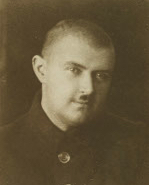Difference between revisions of "Obermiller, E."
| Line 10: | Line 10: | ||
|yeardeath=1935/06/03 | |yeardeath=1935/06/03 | ||
|bornin=Petergof, Russia | |bornin=Petergof, Russia | ||
| − | |bio=Eugene Obermiller (1901-1935), as a Buddhist scholar, inherited the tradition of Ivan Minayev (1840-1890), the founder of Russian school of Indology and Buddhist studies through his teacher Fyodor Ippolitvich Shcherabatskoy (1866-1942), who was a pupil of Minayev. After obtaining his Ph. D. from the University of Leningrad, he joined Academy of Sciences at | + | |bio=Eugene Obermiller (1901-1935), as a Buddhist scholar, inherited the tradition of Ivan Minayev (1840-1890), the founder of Russian school of Indology and Buddhist studies through his teacher Fyodor Ippolitvich Shcherabatskoy (1866-1942), who was a pupil of Minayev. After obtaining his Ph. D. from the University of Leningrad, he joined Academy of Sciences at Leningrad as a Under Secretary to the Director of the Bibliotheca Buddhica. |
His published works include the translation of Bu-ston's Tibetan History of Buddhism (1932) in two volumes. He also translated ''Uttaratantra'' or ''Ratnagotravibhaga'' (of Maitreya Asaṅga) from Tibetan and published it in 1932. Obermiller's another important work is the Sanskrit text and Tibetan translation of the ''Abhisamayālamkara'', which he undertook as joint venture with his teacher Shcherabatskoy and published it in 1929. He also contributed papers to Indian Historical Quarterly. | His published works include the translation of Bu-ston's Tibetan History of Buddhism (1932) in two volumes. He also translated ''Uttaratantra'' or ''Ratnagotravibhaga'' (of Maitreya Asaṅga) from Tibetan and published it in 1932. Obermiller's another important work is the Sanskrit text and Tibetan translation of the ''Abhisamayālamkara'', which he undertook as joint venture with his teacher Shcherabatskoy and published it in 1929. He also contributed papers to Indian Historical Quarterly. | ||
Revision as of 10:46, 30 July 2019
| Birth: | 1901/10/28 |
|---|---|
| Death: | 1935/06/03 |
| Place of birth: | Petergof, Russia |
Tibetan calendar dates
Biographical Information
Eugene Obermiller (1901-1935), as a Buddhist scholar, inherited the tradition of Ivan Minayev (1840-1890), the founder of Russian school of Indology and Buddhist studies through his teacher Fyodor Ippolitvich Shcherabatskoy (1866-1942), who was a pupil of Minayev. After obtaining his Ph. D. from the University of Leningrad, he joined Academy of Sciences at Leningrad as a Under Secretary to the Director of the Bibliotheca Buddhica.
His published works include the translation of Bu-ston's Tibetan History of Buddhism (1932) in two volumes. He also translated Uttaratantra or Ratnagotravibhaga (of Maitreya Asaṅga) from Tibetan and published it in 1932. Obermiller's another important work is the Sanskrit text and Tibetan translation of the Abhisamayālamkara, which he undertook as joint venture with his teacher Shcherabatskoy and published it in 1929. He also contributed papers to Indian Historical Quarterly.
Publications
[1937]
[Bibliotheca Buddhica XXIX:] Prajñā pāramitā-ratna-guṇa-saṃcaya-gāthā. Sanscrit and Tibetan text / Edited by E. Obermlller. Moscow; Leningrad: the USSR Academy of Sciences Press, 1937. 125 p.
[1932]
History of Buddhism in India and Tibet by Bu-ston. Part 2. Translated from Tibetan by Dr. E.Obermiller. Heidelberg 1932.
[1931]
[Bibliotheca Buddhica XXI. Pt. 2:] Sphutārthā Abhidharmakoçavyākhyā, the work of Yaçomitra, Second Koçasthāna. Pt. II / Ed. by prof. U. Wogihara and prof. Th. Stcherbatsky and carried through the press by E. E. Obermiller. Leningrad, Academy of Sciences of USSR, 1931, 96 p.
History of Buddhism (Chos-hbyung) by Bu-ston. Part 1. The Jewelry of Scripture. Translated from Tibetan by Dr. E.Obermiller. With an Introduction by Prof. Th.Stcherbatsky. Heidelberg 1931.
[1929]
[Bibliotheca Buddhica XXIII:] Abhisamayālankāra-Prajñāparāmitā-Upadeša-Šāstra. The work of bodhisattva Maitreya / Edited, explained and translated by Th. Stcherbatsky and E. Obermiller. Fasciculus 1: Introduction, Sanscrit text and Tibetan translation. Leningrad, USSR Acaemy of sciences, 1929, XII, 112 p.
[1928]
[Bibliotheca Buddhica XXV:] Indices verborum Sanscrit-Tibetan and Tibetan-Indices Verborum Sanscrit-Tibetan and Tibetan-Sanscrit to the Nyāyabindu of Dharmakīrti and the Nyāyabinduṭikā of Dharmottara / Compiled by E. Obermiller with a preface by Th. Stcherbatsky; from the edition of the Sanscrit and Tibetan texts by Th. Stcherbatsky. II. Tibetan-Sanskrit Index. Leningrad, USSR Academy of Sciences, 1928. 145 p.
[1927]
[Bibliotheca Buddhica XXIV:] Indices Verborum Sanscrit-Tibetan and Tibetan-Sanscrit to the Nyāyabindu of Dharmakīrti and the Nyāyabinduṭikā of Dharmottara / Compiled by E. Obermiller with a preface by Th. Stcherbatsky; from the edition of the Sanscrit and Tibetan texts by Th. Stcherbatsky. I. Sanscrit-Tibetan Index. Leningrad, USSR Academy of Sciences, 1927.
- Wiki Pages
- Person description or short bio
Expand to see this person's philosophical positions on Buddha-nature.
| Is Buddha-nature considered definitive or provisional? | |
|---|---|
| Position: | |
| Notes: | |
| All beings have Buddha-nature | |
| Position: | |
| If "Qualified", explain: | |
| Notes: | |
| Which Wheel Turning | |
| Position: | |
| Notes: | |
| Yogācāra vs Madhyamaka | |
| Position: | |
| Notes: | |
| Zhentong vs Rangtong | |
| Position: | |
| Notes: | |
| Promotes how many vehicles? | |
| Position: | |
| Notes: | |
| Analytic vs Meditative Tradition | |
| Position: | |
| Notes: | |
| What is Buddha-nature? | |
| Position: | |
| Notes: | |
| Svātantrika (རང་རྒྱུད་) vs Prāsaṅgika (ཐལ་འགྱུར་པ་) | |
| Position: | |
| Notes: | |
| Causal nature of the vajrapāda | |
| Position: | |
